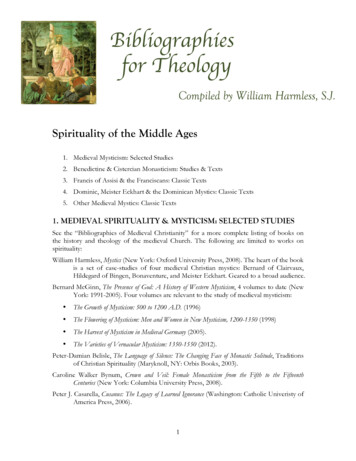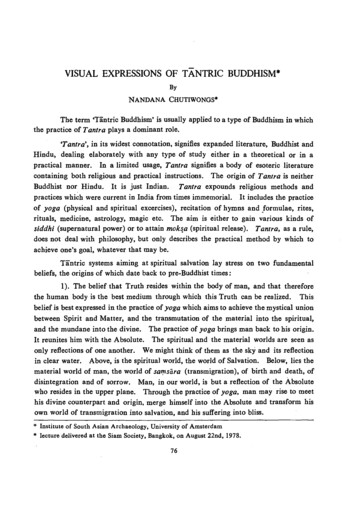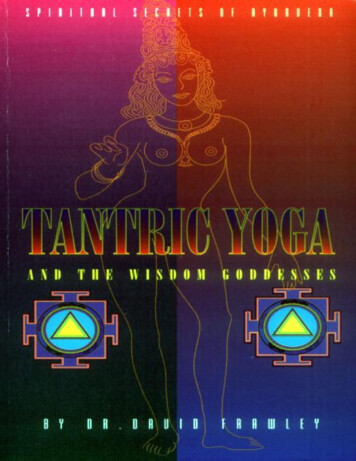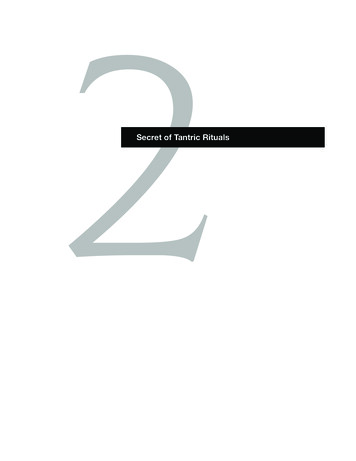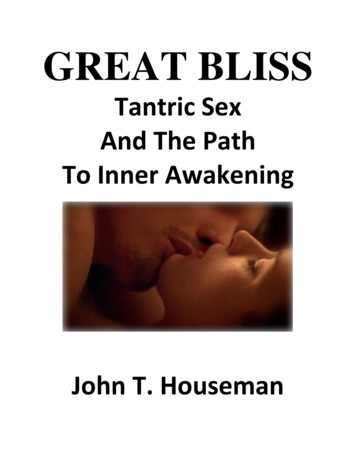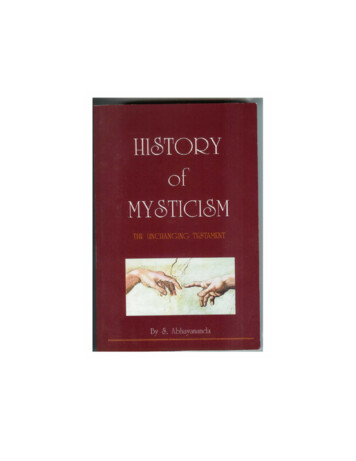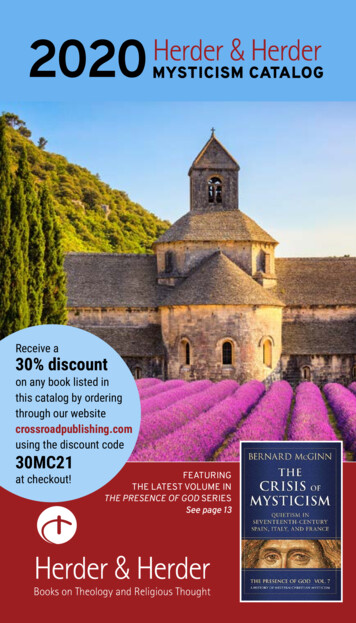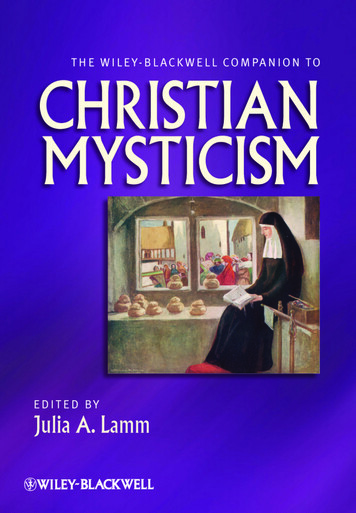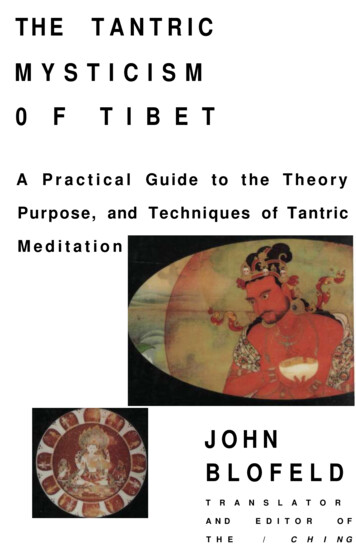
Transcription
THETANTRICMYSTICISM0FT I B E TA P r a c t i c a l Guide to the T h e o r yPurpose, and Techniques of TantricMeditationJOHNBLOFELDTRA N DT H EANSLATOE D I T O R/CHRO FIN G
NOFWISDOM, EXPLAINEDMODERNC L A S S I CSPIRITUALINAOFLITERATUREAnyone who has marveled at the dizzying panoramas of Tibetan art orbeen inspired by the courage and equanimity of the Dalai Lama has asense of the grandeur of Tantric mysticism, the tradition that runsthrough the Vajrayana (or Adamantine Vehicle) Buddhism of Tibet. Thisbook is the first general work on Tantra to appear in English, and itremains the definitive one. With the same lucidity and historical scope hebrought to his famous translation of the / Ching, John Blofeld traces thedevelopment of Tantric mysticism from its origins in MahayanaBuddhism; outlines its aims, techniques, and practices; and discusses therelationship between its ornate supernatural imagery and the archetypesof the human psyche. Here at last is a book that rescues a powerful andsurprisingly practical school of meditation from the misconceptions thathave long surrounded it, making Tantra accessible to both Buddhistsand non-Buddhists who wish to augment their spiritual practice.Cover design by Paul Buckley. Cover art: Top, detail of Hindu Mandala; Vishnuseated on the snake Shesa. The Granger Collection. B o t t o m , detaiI of Naropa.Collection of W o l f g a n g J u n n e m a n , M u n i c h .AN ARKANA BOOKReligionTibetan Buddhism
ARKANATHE TANTRIC MYSTICISM OF TIBETAs a young man, John Blofeld broke off his studies atCambridge in order to go to China. Subsequently, hetraveled extensively in the East and spent much of his timestudying and writing about Buddhism and Taoism in China,Tibet, and Thailand. His books include The TantricMysticism of Tibet, The Secret and Sublime, Beyond the Gods,and a translation of the I Ching (The Book of Change).
1. Vajrasattva Buddha
THETANTRICMYSTICISMOF TIBETA Practical GuideBy John Blofeldtranslator of the I ChingARKANA
ARKANAPublished by the Penguin GroupPenguin Books USA Inc.,375 Hudson Street, New York, New York 10014, U.S.APenguin Books Ltd, 27 Wrights Lane,London W8 5TZ, EnglandPenguin Books Australia Ltd, Ringwood,Victoria, AustraliaPenguin Books Canada Ltd, 10 Alcorn Avenue,Toronto, Ontario, Canada M4V 3B2Penguin Books (N.Z.) Ltd, 182-190 Wairau Road,Auckland 10, New ZealandPenguin Books Ltd, Registered Offices:Harmondsworth, Middlesex, EnglandFirst published in the United States of America byE. P. Dutton & Co., Inc., 1970Published in Arkana 199210 9 8 7Copyright George Allen and Unwin Ltd., 1970All rights reserved(Cip data available)ISBN 0 14 019.336 7Printed in the United States of AmericaExcept in the United States of America, this book is sold subject to thecondition that it shall not, by way of trade or otherwise, be lent, resold, hired out, or otherwise circulated without the publisher's priorconsent in any form of binding or cover other than that in which it ispublished and without a similar condition including this conditionbeing imposed on the subsequent purchaser.
Dedicated to the Lamas and their pupils at Samye Ling,Scotland, and to John Driver
FOREWORDThe Vajrayana or Adamantine Vehicle is the school of MahayanaBuddhism prevalent in Tibet and Mongolia. A highly practicalform of mysticism, it affords precise techniques for attainingthat wisdom whereby man's ego is negated and he enters uponthe bliss of his own divinity.For more than a thousand years, these techniques - developedat Nalanda University in India at the time of the Romanoccupation of Britain - were handed down from teacher todisciple and carefully guarded from outsiders. A few years ago,tragedy struck Tibet sending its people fleeing in thousandsacross the frontiers. Since then, the Lamas have come to recognize that, unless their homeland is recovered within a generation,the sacred knowledge may decline and vanish. Hence they areeager to instruct all who sincerely desire to learn. In this onerespect, Tibet's tragic fate has been the world's gain.Mysticism, or the search for divine truth within the mind,has always existed among small groups everywhere; but theTantric mystical techniques have few parallels in other religionsor in other schools of Buddhism; many of them are virtuallyunique. Besides being of absorbing interest to students ofBuddhism (especially Zen) and of psychology, a study of themwill reward everyone who seeks to lift aside the veil of appearances and penetrate to the very source of all divinity and wisdom.The way of the Vajrayana is the Way of Power which leadsto the mastery of good and evil. It is also the Way of Transformation whereby inward and outward circumstances aretransmuted into weapons by the power of mind. It goes withoutsaying that progress in conjuring so vast a transformation isnot easy and not to be accomplished by liturgies and sacredformulas. Here as everywhere, Mind is the King. Who,without adamantine strength of will, can attain the stature of agod in this very life? The whole of the adept's being, experienceand environment - good and evil - must be harnessed to hispurpose.The first requirement is indomitable resolution; the second9
FOREWORDis a teacher who teaches not only from sacred texts but alsofrom experience and an illumined mind. In the West, such menare scarcely more plentiful than Wish-Fulfilling-Gems; butamong the Tibetan refugees who have poured into India,Sikkim and Nepal are enlightened Lamas from the greatmonastic seats of learning and accomplished yogins drivenfrom their mountain fastnesses. Of these, a handful have madetheir way to Europe and America to work in universities or tofound gompas in lonely places that will become centres ofmeditation. Already, Samye Ling, a small gompa on theScottish moors, has attracted a band of Lamas and more studentsthan it can accommodate.Once these Lamas have mastered European languages, bookslike this one will be outmoded. We may expect from theirpens authoritative works setting forth the teaching more openlythan was ever done in Tibet because already they have come torealize that maintaining the ancient safeguards would be tothreaten the Vajrayana with extinction. Not all their pupilswill be Buddhists, for others may find it fruitful to adapt theTantric techniques to their spiritual life. In the meanwhile,it behoves us Western followers of the Vajrayana to introducethe subject as best we can. Hence this book. I hesitated overwriting it for some ten years, feeling that my knowledge isinadequate and knowing that it is usually best to be silent untilour spiritual progress fits us to speak with authority; mydecision to write it was taken at last, despite insufficientprogress, because I believe there is a growing interest in theVajrayana and it is certainly high time to clear up the grotesquemisunderstandings about Tantric Buddhism to which the traditional secrecy has given rise.In Tibet, the vital oral teachings without which Tantricworks are enigmas are accompanied by an injunction not tospeak of them without permission. To allow a half-fledgedmedical student to practise as freely as a qualified doctor wouldbe less dangerous than to permit novices to set themselves upas the teachers of techniques able to revolutionize, not merelythought, but the mind itself. Wrongly applied, they couldlead to madness and worse than madness.10
FOREWORDThis book barely touches upon the history, development andpresent status of the Vajrayana, and upon the different schoolsand sects. It is chiefly concerned with Tantric method - themeans of achieving the extraordinary results that flow frommind control and the negation of the ego. The idea that Tantrictechniques could be adapted for use outside the Buddhist folddawned on me and has grown as the outcome of two circumstances - the separate visits of an English and an AmericanBenedictine abbot to Bangkok who were eager to study Buddhistmeditational methods, and my chancing to learn of severalCatholic dignitaries engaged in similar studies. Moreover, inAustralia, one or two Quakers I met expressed deep interest inthe Vajrayana. I have as yet no idea of how much can be gainedby practising Vajrayana techniques outside their Buddhistcontext and I should prefer to see the entire Dharma acceptedtogether with the techniques. Nevertheless, spiritual progressand attainment are no one religion's prerogative; they are opento all men of vision and determination.Believing the Vajrayana to be one of the loveliest flowers ofman's spiritual achievement, I am sure I have failed to do itjustice. A description of the sky's immensity by a frog peeringat the stars from the bottom of a well is bound to be deficient.JOHN BLOFELDBangkok 28/12/6811
CONTENTSFOREWORD9PART I BACKGROUND AND THEORYi. The VajrayanaMystical IntuitionsThe Need for the Sacred QuestChoice of a PathThe Tantric WayThe Vajrayana in TibetThe Vajrayana for the West.23232629313642ii. The Mahayana SettingThe Roots of the VajrayanaThe Concept of No GodThe Concept of No SelfThe Concept of ImpermanenceThe Concept of 'Suffering'The Concept of RebirthSamsara and NirvanaKarma and CausalityMerit and its TransferThe'Elements of Being'Buddhas and BodhisattvasExperiential Evidence45455153545455566061616366iii. The Essence of the Tantric MethodPurposeReasons for SecrecyThe GuruVarious Types of AdeptThe Short PathAttitudeConductVisualizationThe Interplay of Body, Speech and MindThe Significance of Rites6969707373747678838790I3
CONTENTSFruits of the PathUnconventional Moralityiv. Psychic and Material SymbolsA Question of RealityThe Purpose of the Symbols and DeitiesA Pre-Tantric ParallelThe MandalaThe Peaceful and Wrathful Deities of the MandalaThe Vajra or Adamantine SceptreThe Wheel of LifeThe ChortenPART II919294949899102110117119122PRACTICEi. AspirationGeneralThe RefugesThe Bodhisattva VowObtaining a GuruThe GuruThe Adept as the BuddhaInitiation12912913S135136139142143ii. The PreliminariesPurposeThe Grand PostrationsThe RefugesThe Generation of BodhicittaThe Vajrasattva PurificationThe Mandala OfferingOthers147147150153157159163167iii. General PracticeIntroductoryDaily PracticeThe Importance of the YidamThe Shrine16916917317618214
CONTENTSRegular Rites and MeditationsSpecial RitesThe Chod RitePreparation for DeathMeditation in CemeteriesPilgrimageSpecial Uses of Mantras185188189190192192194iv. The SadhanasThe General ContentThe Sadhana of the Essence of the Profound MeaningThe Fruits of the PracticeThe Essential CoreThe Arya Tara SadhanaThe Suitability of the Sadhana Practice for WesternAdepts198198201212215216v. Advanced PracticeThe Divisions of Tantric PracticeSupernormal PowersTransmutation of Passions and DesiresYogic Practices Pertaining to the Path of FormYogic Practices Pertaining to the Formless PathThe OSSARYL I S T OF USEFUL BOOKS C O N T A I N I N G M A T E R I A LO N T A N T R I C BUDDHISM21624925315
ILLUSTRATIONSILLUSTRATIONS1. Vajrasattva BuddhafrontispieceThe central figure in the mandala of the five Jinas. Itrepresents Pure Absolute Wisdom. The colour is whiteand the hands are in the preaching gesture. (Drawn bySherabalden Beru of Samye Ling Tibetan Centre,Dumfriesshire).2. Guru Rimpoche" in mature guise40A'The Precious Teacher' in mature guise. This is thetitle given to Lama Padma Sambhava who introducedBuddhism from India to Tibet in A.D. 747. He is honhoured as the founder of Tibetan Buddhism and as theSacred Patron of the Nyingmapa sect.The vajra-sceptres in his right hand and on hishead-dress symbolize the adamantine power by whichdelusion is destroyed. The skull-cup containing a vial ofnectar symbolizes immortal wisdom; and the tridenttransfixing three human heads stands for dominion overdesire, passion and delusion. (A print sold in Kalimpong.)S. The Buddha of the Naga Realm64 AThe nagas, some of whom appear at the bottom of thepicture, are beings who often appear as dragons ormany-headed snakes. Here they are human in form fromthe waist up. The Buddha who preaches to them is bluein colour and may be connected with Manjusri Bodhisattva, embodiment of supreme wisdom. (A valuableMongolian painting.)4. Amitayus Buddha, an aspect of Amida Buddha88AThe crown and ornaments reveal that this is the BlissBody of Amida Buddha, the Jina to the west of themandala's core. He is almost always pinkish red in17
ILLUSTRATIONScolour, but occasionally white, as here. The positionof the hands identifies him. Symbolizing boundless lightand (in this Amitayus form) longevity, he holds a vialof the nectar of immortal wisdom. (A valuable Mongolian painting.)5. A Grand Initiation Mandala102AThis was painted on the floor of a temple in Hangchowin the 1930s to serve for initiations conducted by thePanchen Lama when (during his previous incarnation)he visited east China. It is similar to the mandala described in this book, except that the deities are represented by signs instead of figures and that its core isnot in the usual fivefold form, but ninefold, i.e.Moreover at the very centre is a circular tower which,like those on the outer rim, is not painted but standsupon the painting. (Photograph supplied by Mr GeraldYorke.)6. The Wheel of Life120AThe profound symbolism of this pictorial representationof the Sacred Doctrine is described in the appropriatesection. (Painted by the palace artist of Sikkim.)7. A Chorten122AThe unusual history of this reliquary tower is relatedin the footnote at the end of Part I, chapter 4. (A beautiful example of Tibetan metal-work from Lhasa.)8. Maha Arya Tara {The GreenDrolma)178AThe Green Tara (or Drolma), a beneficent 'deity' verywidely adopted as a Yidam. She embodies compassionand protection. (Painted by the palace artist of Sikkim.)9.18Yamantaka (The wrathful form of Manjusri 178cBodhisattva)The wrathful form of Manjusri, embodiment of wisdom.Widely adopted as a Yidam by those with fierce passionsto cleanse, he is also one of the Guardians of the Gelugpa
ILLUSTRATIONSsect. His body is blue (wisdom); the severed heads andcorpses represent evil propensities conquered by wisdom.(Painted in Kalimpong.)10. Ritual implements184ATo the left is a vajra-sceptre and vajra-bell, to the right apot of the nectar of wisdom. In the centre are threebutter-lamps and seven offering-bowls. At the back isan oblong incense-burner. (The pot, lamps and waterbowls are silverware from Sikkim.)11. A visualization diagram208ASuch diagrams are used when teaching a sadhana tobeginners. In the Arya Tara sadhana, a white Bhamappears and changes into a white lotus, from which risesa white Ah. This becomes a moon-disk on which a greenDham appears and changes into a blue lotus with ashining green Dham in its calyx. (Drawn in Kalimpong.)12. Three Guardians of the Nyingmapa sect250AThese are the principal Guardians of the Nyingmapasect, whose duty it is to uphold the Dharma and discourage breaking of the Samaya-pledge. Before theirconversion to Buddhism, they may perhaps have beenawe-inspiring daemonic forces.DIAGRAMS1.2.3.4.5.6.The Chinese yinyang symbol100Outline of a mandala104A, B, C and D. Four keys to the core of a mandala 105-8Key to the symbolism of the Wheel of Life120Key to the symbolism of a chorten123The method of performing grand prostrations 151(All the diagrams are fully described in the text)19
Part IBACKGROUND AND THEORY
CHAPTERITHE VAJRAYANAMystical IntuitionsThere are moments during life when a startling but marvellousexperience leaps into mind as though coming from anotherworld. The magic that calls it forth - as though someone hadaccidentally whispered the 'open sesame' that rolls the stoneback from the hidden treasure - is often so fleeting as to beforgotten in the joy of the experience. It may be a thin cadenceof music: a skylark bursting into song, the plash of a wave, aflute played by moonlight. It may be a grand harmony of sound,peaceful or awe-inspiring: the murmurous voices of a summer'safternoon or the fateful shrieking and drumming of a mountainstorm. It may be something seen: a lovely smile or the curveof an arm; a single gesture, form or hue of compelling beauty;a familiar scene transformed by an unusual quality of light; amajestic panorama of .interweaving colours splashed acrosssea or sky; a cluster of rocks suggestive of enormous beingsimbued with life. Or the spell may be wrought by a suddenexaltation springing directly from the mind and jerking it, soto speak, into an unknown dimension.That the experience is not a passing fancy but an intimationof something profoundly significant is recognized in a flash,but understanding of its significance does not always follow.A curtain hitherto unnoticed is suddenly twitched aside; and,though other veils intervene, for a timeless moment therestands partially revealed - a mystery. Then the curtain falls inplace and at least a measure of oblivion descends.'Mystery' is not a satisfactory term, but what else can besaid of it? It has a hundred names, all of them inapt. It has beencalled the Good, the True, the Beautiful and all of these together. Philosophers term it the Absolute or Ultimate Reality.23
T H E TANTRIC MYSTICISM OF TIBETTo Christian mystics it is known as the Godhead and toChristians in general as God. It is the Brahma and Para-Atmaof the Hindus, the Beloved of the Sufis, the Tao or Way of theTaoists. Buddhist names for it vary with the context: Nirvana,the Womb of Dharmas, Suchness, the Void, the Clear Light,the One Mind. In the words of the Chinese sage Lao-tze,'The Way that can be conceived of is not the Eternal Way;the Name by which it can be named is not its Eternal Name.'Of late, some psychologists have displayed an awareness of itby suggesting the need for 'integration' with something reachingfar beyond ourselves. William James spoke of it obliquely.Were it not that frequent and clear visions of it engender acompassionate urge to communicate the bliss, it would be bestto use no name at all.Names set bounds. Unfathomable by the keenest scientificprobing, the mystery can be intuited but never grasped, howthen named?Mystics and poets are supremely fortunate in that visions ofit sometimes dawn on them unsought; hearty extroverts, if theyglimpse it at all, are shocked into fears for their sanity. Uncomfortably they dismiss it as a mental aberration - or run for the doctor!Attempts to define it succeed no better than the search for aname. To say that it exists is to exclude from it the nonexistent and limit it to what speaker or hearer means byexistence. To say that it does not exist involves the other sideof the dilemma. Both concepts are too crude to describe itssubtle nature. To say, as many do, that it is pure mind is wellenough in certain contexts, but it ought not to be set apart frommatter with which it is inseparably united. To say that it is atonce material and otherwise is to play with words.However, man's consciousness cannot easily divest itself ofsymbols. Accomplished mystics tend to describe it in terms ofthe qualities lent to it by the filter of their senses: ClearRadiance, Immaculate Void, Ecstatic Bliss, Infinite Love, AilEmbracing Unity.Clear and profound intuitions of the mystery are not limitedto any period, region, kind of person or religious faith. Knowledge of it has come from widely varied sources: the Egyptian24
THEVAJRAYANAand Greek mystery cults, the Druids (so it is said), the tribalpeoples of the two Americas, people with no particular religiousfaith and followers of all the world's great religions. On thewhole, however, religious authorities seem to fear it. Mysticismhas seldom been encouraged (and sometimes savagely repressed)by the Catholic and Protestant Churches, by orthodox Muslims- that is to say non-Sufis - and by the Confucians, althougheach of these communities has produced some notable mystics.The reason for this attitude seems to be that mystics, intoxicated with their vision, no longer care for conventional forms;like artists, they offend against propriety. The ChristianOrthodox Church of Greece and Russia seems less hostile, buteven there exoteric, liturgical religion prevails. The Taoists,once mystics par excellence, have by and large turned to magic.The Hindus, to their everlasting credit, allow freedom forevery sort of religious belief and practice, but even among themtrue mystics are a minority.Buddhism is perhaps the one widespread religion which, intheory at least, is wholly mystical, for it recommends to all itsfollowers the practice of mind control and the attainment ofintuitive wisdom. Even so, among Buddhists, people activelyengaged in the sublime search are less common than might besupposed except for a few schools and sects of which theVajrayana is one.Confirmation of the genuineness of the mystical experienceis to be found in the high degree of unanimity observable in theattempts to describe its nature. Descriptions by people widelyseparated in time and place are strikingly similar, especially ifallowance is made for four diversive factors; the impossibilityof accurately describing an experience that transcends allconcepts for which words exist; the pious tendency to reconcileall religious experience with cherished doctrines; the prohibition in some societies against expressing views not inaccord with the prevailing doctrines; and the need to makedescriptions intelligible and acceptable to others. The underlying unanimity which characterizes the mystical writings of allfaiths is well brought out in Aldous Huxley's Perennial Philosophy. If, as the cynics would have it, the mystical experience25
THE TANTRICMYSTICISM OF TIBETis sheer illusion, the stuff of dreams, it is strange that men andwomen belonging to widely different environments have,throughout the centuries, suffered the same delusions anddreamed the same dream.No one who has had several intense or prolonged mysticalexperiences doubts their validity, but what is intuited is sohard to communicate that the mystics' virtual unanimity is theonly evidence that can be offered to the world at large. Noris the value of these experiences easy to demonstrate. Indeed,from the point of view of society, they must seem detrimental,for a mystic can no more subscribe to mundane values thanunicorns can behave like bees or ants. Nevertheless, the peopleconcerned regard them as the most worthwhile happeningsin their lives: they are tormented by a thirst to regain them andprolong the bliss for ever. The possibility of attaining tounexcelled beauty, truth and ecstasy makes it natural to renounce all other goals.Unhappily modern life is not conducive to the spontaneousdawning of the experience; people are so used to filling theirleisure with gay distractions that the surface of their minds isseldom placid. Scholars are too preoccupied with investigatingdetails of the outward flux to pay much heed to those whospeak of a sublime truth discoverable within; but it must be saidthat their unwillingness to experiment with the techniquesaffirmed to lead to that discovery ill accords with their spiritof scientific enquiry. No doubt, the reason is that the techniquesdemand prolonged exertion to achieve a goal of which they doubtthe very existence.The Need for the Sacred QuestThere are a fortunate few to whom powerful intimations of thesacred mystery come unsought and others who, accepting theaffirmations of accomplished mystics, have faith in its reality.For them it would be unthinkable not to seek the source andthere dwell for ever. For the rest, the conclusions forced on usby an unprejudiced examination of the human lot ought to beshattering enough to make us eager to try every means of26
THEVAJRAYANAtransforming it into something less inherently tragic. With thepassing of youth, life's rainbow glitter soon wears off; one byone the shining bubbles burst and the 'shades of the prisonhouse' close in.Even those who escape great physical distress in the form ofdisease, hunger, want or back-breaking toil find happinesselusive. True, in the more advanced countries, crushing povertyis becoming rare; few women die in childbirth or needlesslylose their babies for want of care; unshod waifs are no longerseen upon the streets; no hordes of children grow up sickly forlack of nourishment; no corpses lie by the wayside to bedevoured by dogs and flies; musicians no longer cough awaytheir lives in icy garrets; no children singe their flesh againstthe bricks of soot-filled chimneys or drag heavy loads upforbidding flights of stairs. Yet, even if we dare ignore thethree-quarters of the human race who still toil like buffaloes forthe means of bare subsistence, who can say that life brings morejoy than discontent? Whereas hunger is always hunger, coldalways cold and pain always pain, pleasures diminish withrepetition; real satisfaction is less familiar to the gourmet thanis pain to the human donkey sweating away his life in an Easternsugar mill. Moreover it now appears that, where wealth abounds,want and insecurity have been replaced not by happiness butby mounting boredom and frustration. Blindly accepting theviews of Darwin and his heirs, including Marx, we have reposedall our faith in material progress. With what result?That the need for a radical readjustment of our aims isdesperate can be deduced from the unprecedented rise in theincidence of nervous maladies, from the motiveless crimesperpetrated by well-fed, well-educated children, from thehideous examples of mass cruelty carried out by civilizednations on a scale worthy of Attila or Genghis Khan, and fromthe terrifying speed with which we are rushing towards theabyss of world destruction.What a joy if we could come upon some means of lastingsatisfaction that would give meaning to our existence andsweep away cruelty and frustration! Aesthetic and intellectualsatisfactions are subject to the same law of diminishing returns27
THE TANTRICMYSTICISM OF TIBETas the cruder forms of sensual pleasure. Organized religion toooften resembles a bone-dry vessel from which the water of lifehas long been drained away. How good if men would heed theprecious counsel 'Look within' and embark on the sacredquest!No doubt most thoughtful people will agree that the tremendous social and scientific advances of this century have,even in the most privileged communities, added far less to thesum total of human happiness than was expected, besidescreating new dangers. They will readily see the need for afresh approach, but not many are likely to have patience withsomeone who offers an Eastern religion as the remedy. Theday has passed when missionary-minded folk could raucouslyproclaim that they and their fellows were the sole custodiansof the divine will and that whoever thought differently wouldroast throughout eternity. By and large people have rejectedreligious solutions to life's unsatisfactoriness and regard thosewho propose them as crackpots, bigots or both.What is proposed in these chapters is not necessarily a returnto religion in exotic oriental guise, but a return to the wisdomthat antedates all religions and has been distorted, overlaid andhidden by centuries of misguided religiosity. That this wisdom,or the means of achieving it, has been presented in accordancewith Tibetan tradition is because, owing to a combination ofgeographical and historical circumstances, knowledge of theroad to it has been preserved in Tibet more fully than elsewhere.Tibet, as it was up to the recent Communist invasion, was theone living link with the ancient world that still remained - ifwe exclude the pockets of rather primitive culture found hereand there in inaccessible places. Tibet's culture, though ancient,is far from primitive. True, there are Tibetan nomads andmountain tribes living in conditions as close to natural as anyin the world, but the learning preserved until recently inTibet's great monasteries is, in the main, of a highly sophisticated kind.In reading about Tibetan mysticism, a clear distinction hasto be made between what is essential and what is fortuitous.The ancient wisdom has naturally been preserved in a form28
THEVAJRAYANAsuited to Tibet - a country where demigods and demons areaccepted by most people as being no less real than eagles andscorpions. In presenting my material, I have seldom venturedto separate aspects which seem to me of principal value fromthose whose worth strikes me as dubious, because I feel unqualified to draw the dividing line. I have written as one who,having been accepted as a disciple by several outstandingLamas, naturally tries to follow their teaching in all respects.Yet I do not for one moment suppose that it is all equallyprecious.My purpose can be understood from an analogy. Suppose thatthe ancient wisdom is a treasure locked in a vast mine to whichonly one entrance remains open. I have tried to describe thatentrance and the passageways leading into the mine as I sawthem. I believe implicitly in the inestimable value of thetreasure; I do not, however, take it for granted that the approach revealed to me is the only one or necessarily the bestone. If others can find another approach more consonant withtheir dispositions, so much the better - so long as it reaches thetreasure and does not leave them groping in the darkness ofthe mine. Until such a way is found, we had best make do withthe present one, altering it perhaps to suit our special needs.The Choice of a PathIn most well-to-do communities, disillusion with the resultsof material progress has already become widespread and thenumber of people turning to mystical oriental faiths, thoughstill not great, has grown astonishingly. In England and theUnited States especially, there are flourishing meditationcentres which have to turn away students for lack of accommodation. Buddhist and Brahminist groups flourish in placeswhere twenty years ago such a development could not beimagined an
THE TANTRIC MYSTICISM OF TIBET As a young man, John Blofeld broke off his studies at Cambridge in order to go to China. Subsequently, he traveled extensively in the East and spent much of his time studying and writing about Buddhism and Taoism in China, Tibet, and Thailand. His books include The Tantric


